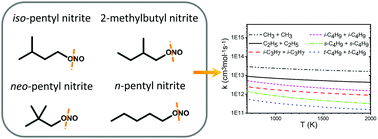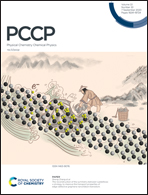An experimental and theoretical study of the high temperature reactions of the four butyl radical isomers†
Abstract
The high temperature gas phase chemistry of the four butyl radical isomers (n-butyl, sec-butyl, iso-butyl, and tert-butyl) was investigated in a combined experimental and theoretical study. Organic nitrites were used as convenient and clean sources of each of the butyl radical isomers. Rate coefficients for dissociation of each nitrite were obtained experimentally and are at, or close to, the high pressure limit. Low pressure experiments were performed in a diaphragmless shock tube with laser schlieren densitometry at post-shock pressures of 65, 130, and 260 Torr and post-shock temperatures of 700–1000 K. Additional experiments were conducted with iso-butyl radicals at 805 K and 8.7 bar to elucidate changes in mechanism at higher pressures. These experiments were performed in a miniature shock tube with synchrotron-based photoionization mass spectrometry. The mass spectra confirmed that scission of the O–NO bond is the primary channel by which the precursors dissociate, but they also provided evidence of a minor channel (<7.7%) through HNO loss and formation of an aldehyde. These high pressure experiments were also used to determine the disproportionation/recombination ratio for iso-butyl radicals as 0.3. Reanalysis of the lower-temperature literature and the present data yielded rate constants for the disproportionation reaction, iso-butyl + iso-butyl = iso-butene + iso-butane. A chemical kinetics model was developed for the reactions of the butyl isomers that included new paths for highly energized adducts. These adducts are formed by the addition of H, CH3 or C2H5 to the butyl radicals. Accompanying theoretical investigations show that chemically activated pathways are competitive with stabilization of the adduct by collision under the conditions of the laser schlieren experiments. These calculations also show that at 10 bar and T < 1000 K stabilization is the only important reaction, but at higher temperatures, even at 10 bar, chemically activated product channels should also be considered. Branching fractions and rate coefficients are presented for these reactions. This study also highlights the importance of the radical structure for determining branching ratios for disproportionation and recombination of alkyl radicals, and these were facilitated by theoretical calculations of recombination rate coefficients for the four butyl radical isomers. The results reveal previously unknown features of butyl radical chemistry under conditions that are relevant to a wide range of applications and reaction mechanisms are presented that incorporate pressure dependent rate coefficients for the key steps.

- This article is part of the themed collection: 2020 PCCP HOT Articles


 Please wait while we load your content...
Please wait while we load your content...
